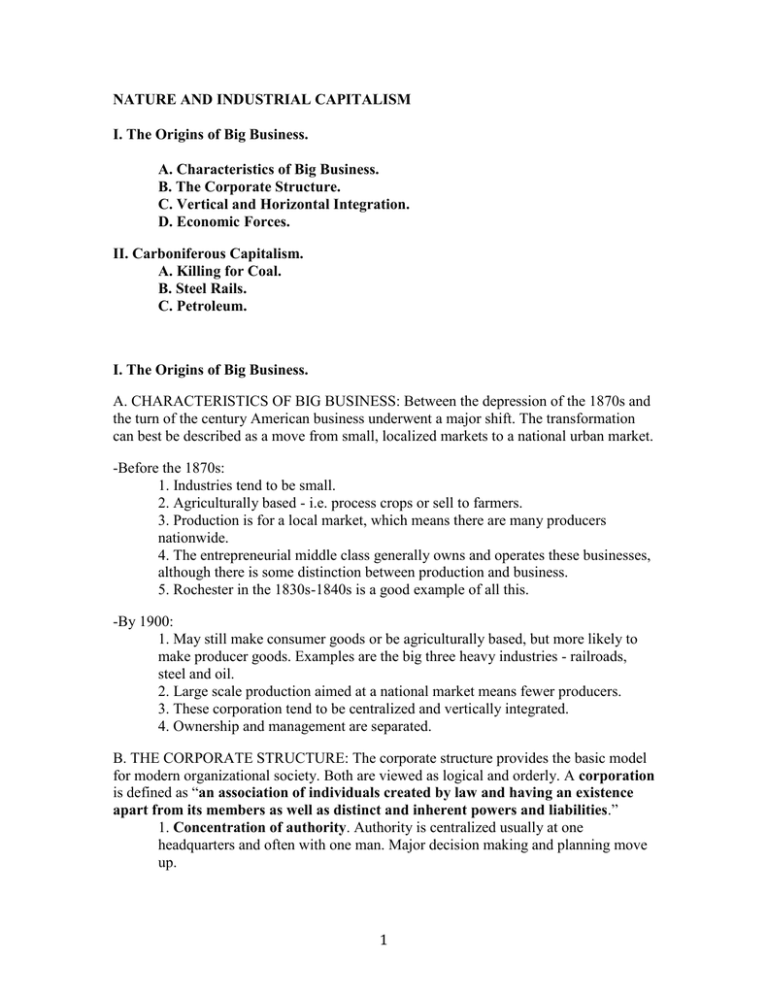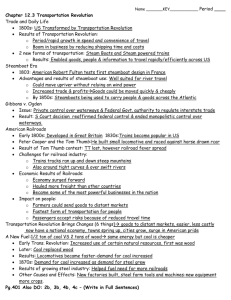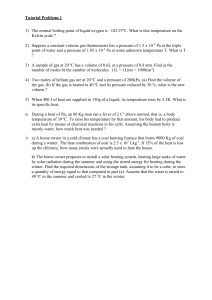NATURE AND INDUSTRIAL CAPITALISM I. The Origins of Big
advertisement

NATURE AND INDUSTRIAL CAPITALISM I. The Origins of Big Business. A. Characteristics of Big Business. B. The Corporate Structure. C. Vertical and Horizontal Integration. D. Economic Forces. II. Carboniferous Capitalism. A. Killing for Coal. B. Steel Rails. C. Petroleum. I. The Origins of Big Business. A. CHARACTERISTICS OF BIG BUSINESS: Between the depression of the 1870s and the turn of the century American business underwent a major shift. The transformation can best be described as a move from small, localized markets to a national urban market. -Before the 1870s: 1. Industries tend to be small. 2. Agriculturally based - i.e. process crops or sell to farmers. 3. Production is for a local market, which means there are many producers nationwide. 4. The entrepreneurial middle class generally owns and operates these businesses, although there is some distinction between production and business. 5. Rochester in the 1830s-1840s is a good example of all this. -By 1900: 1. May still make consumer goods or be agriculturally based, but more likely to make producer goods. Examples are the big three heavy industries - railroads, steel and oil. 2. Large scale production aimed at a national market means fewer producers. 3. These corporation tend to be centralized and vertically integrated. 4. Ownership and management are separated. B. THE CORPORATE STRUCTURE: The corporate structure provides the basic model for modern organizational society. Both are viewed as logical and orderly. A corporation is defined as “an association of individuals created by law and having an existence apart from its members as well as distinct and inherent powers and liabilities.” 1. Concentration of authority. Authority is centralized usually at one headquarters and often with one man. Major decision making and planning move up. 1 2. Diffusion of responsibility. There is too much to know so people specialize even more. Marketing, accounting, acquisitions, production, shipping, etc. "Experts" manage each area. 3. This is the streamlining of business just as businesses are streamlining nature! C. VERTICAL AND HORIZONTAL INTEGRATION: Are two ways to organize largescale business. Both have their advantages but in the long run the biggest corporations will seek to vertically integrate. 1. Explain differences. 2. Vertical Integration happens first in new industries. D. ECONOMIC FORCES: Major forces were at work in the economy since 1815 that led to the rise of big business. 1. Westward migration (1815-1850) leads to expanding internal market and access to raw materials. 2. Railroads create a "national" urban market and speed westward expansion (1850s to 1870s) a. Creates large cities b. Railroads create a major producer market because they consume 75% of the steel and much of the oil. 3. Small companies cannot meet the demands of national and urban markets after the 1870s. 4. New sources of power and new technology – The US enters the “Paleotechnic phase.” 5. Application of science in management and research 6. Productivity in agriculture. a. Mechanization frees workers. b. Creates market for consumer goods-farm specialization. c. Brings in foreign capital. 7. Inflow of foreign capital. European investment is a major source of capital. II. Carboniferous Capitalism. -The rise of industrial capitalism in the years after the Civil War not only saw the emergence of the corporation as the dominant form of business organization, it was based on a shift of enormous consequence for human relationships to the environment – the move toward burning fossil fuels to power industry. Lewis Mumford called this the age of “carboniferous capitalism” and decried both its environmental impacts and degradation of labor. - Thomas Andrews defines this as a move from an organic energy economy to a mineral intensive economy. As easy as it is to criticize the effects after the fact it is important to understand the economic/ecological advantages of fossil fuels for the capitalists. 1. Organic sources of energy – essentially wood, water, wind, and muscle – can fluctuate and ultimately are linked to finite surface of the Earth and the flow of solar energy to the earth in a given year. 2 2. Organic energy economies could and did expand through expansion into marginal lands and improved efficiency, but that expansion was always moderate. David Ricardo’s “law of diminishing marginal returns.” 3. Mineral intensive economies literally mined the accumulated solar capital stretching back hundreds of millions of years. 4. Mineral intensive economies also mitigated the effects of seasonal fluctuations in power, enjoying constant flow of energy. A. KILLING FOR COAL: Coal was the first great fossil fuel of industrialization and remains today the most important in terms of producing electrical energy worldwide. It was not a new discovery. Humans had used coal for thousands of years, but it was not until the rise of industrialization and the resulting deforestation that coal supplanted wood as the major source of heat and power. -Coal is a sedimentary rock formed by the burial and compression of decaying vegetation. Much of the Coal of Europe and the Eastern United States dates to the Carboniferous Period (360-300 MYA) but coal deposits in Colorado and other places only date the Cretaceous Period (70 MYA) 1. Plants use the sun’s energy to transform water and carbon dioxide into oxygen and carbohydrates. This becomes the base of the food chain and “sequesters” most of the Earth’s carbon. 2. As plants die, decompose, and are buried under layers of sediment some of those carbohydrates are trapped and become coal. 3. After bacteria consume approximately half of the organic matter the rest sank into the swamps where the weight of later material first formed mats of peat. 4. If sediments bury this peat and completely shut off the sun, biological processes come to a halt, and physical processes, heat and compression, take over. Lignite: Increased pressures and heat from overlying strata caused buried peat to dry and harden into lignite. Lignite is a brownish-black coal with generally high moisture and ash content and lower heating value. Geologically, is the youngest and the lowest ranked coal, containing 25 to 35 percent carbon and the lowest heating value - 4,000 to 8,300 BTUs per pound. However, it is an important form of energy for generating electricity, particularly in the American Southwest, and to produce synthetic natural gas and liquids. Lignite is found in the Gulf Coast and Northern Plains of the United States. Lignite reserves account for 9 percent of the United States' coal reserves. Subbituminous: Under still more pressure, some lignite was changed into the next rank of coal: subbituminous. This coal is a combustible mineral formed from the remains of trees, ferns and other plants that existed and died during the time of the dinosaurs. A dull black coal with a higher heating value than lignite, it is used primarily for generating electricity and for space heating. It contains about 35 to 45 percent carbon and has a heating value between 8,300 to 11,500 BTUs per pound. Subbituminous coal is predominately found in Montana, Wyoming, UTAH, Colorado, New Mexico, Washington, and Alaska. Subbituminous coal accounts for about 37 percent of the coal reserves in the United States. 3 Bituminous: Sometimes called "soft coal" it is the most common type of coal found in the United States. It is 45 to 86 percent carbon, softer than anthracite, and has a heating value between 10,500 and 14,000 BTUs per pound. This is the type most commonly used for electric power generation in the U.S. and for producing coke for the steel industry. About 52 percent of the United States' coal reserves are bituminous coal. Anthracite: Sometimes called “hard coal,” anthracite was formed from bituminous coal when great pressures developed in folded rock strata during the creation of mountain ranges. Anthracite has the highest energy content of all coals. It contains 86 to 97 percent carbon, and has a heat content of nearly 15,000 BTUs per pound. It is used for space heating and generating electricity. There are about 7.3 billion tons of anthracite reserves, located in 11 counties of northeastern Pennsylvania. Anthracite accounts for about 2 percent of the coal reserves in the United States. -Ironically the production of coal – which allowed the escape from organic energy systems and the increased mechanization of other industries – remained largely a handcraft into the early twentieth century. 1. Coal mining techniques developed in the British Isles made there way to America. Welsh, British, and British-American miners dominated the industry early on. 2. Initial development required tunneling through to the coal seam, followed by the establishment of a grid system of tunnels to haul out the coal. 3. Room and Pillar system used throughout the mine. 4. Colliers then chipped away at the base of the coal face and then drilled holes to place explosives. 5. After the blast the coals was loaded into carts that were take to the surface or a lift via mule power. -The “workscape” of a coal mine was an alien environment for any living thing and was extremely dangerous. 1. Collapses were a common threat as once coal is exposed to oxygen it weathers rapidly. Miners used wooden timbers to prop up the ceiling and left pillars of coal in place for stability. 2. Deforestation was a common effect – especially in the West where wood was scarce. 3. Miners were paid on the tonnage system so they were not paid for this safety work and some took chances by removing pillars – mention “retreat mining” and the Crandall Canyon mine disaster of 2007. 4. Water posed a constant problem and stream pumps were employed to keep water out of the mines. 5. Ventilation was another constant concern as deadly carbon monoxide and methane could lead to suffocation or explosions. “Stinkdamp, blackdamp, afterdamp, firedamp.” 6. Finally, chronic exposure to coal dust lead to pneumoconiosis or “Black Lung Disease.” 4 7. Spectacular mine disasters could kill dozens or hundreds of men. The Winter Quarters Mine in Scofield, Utah exploded on May 1, 1900 killing 200 (about half from the poisonous afterdamp) making it the most deadly mining disaster in American history to that date. In December 1907, 362 men died in Monongah, WV, in the worst mining disaster in American history. 8. In large part due to the conditions in the mines the coal industry saw chronic labor unrest including the Bituminous Coal Miners Strike of 1894 and the Colorado Coalfield War of 1913-1914. -Today underground mining continues and results in deadly accidents such as the Upper Big Branch mine disaster that killed 29 in 2010. Increasingly, however, strip mining became the method of choice with “mountain-top” removal being the most controversial modern variant. B. STEEL RAILS: The greatest consumers of coal were the intertwined industries of railroads and steel. -More than any other technology the railroad represented the attempt to standardize and mitigate the unevenness, the “naturalness,” of nature. 1. By allowing the transportation of commodities via direct routes in all seasons, railroads were essential in the rise of industrial capitalism. 2. As railroads came to dominate American transportation systems they became the largest of all “producer industries” spurring the growth of coal, steel, and petroleum production. In the west railroads developed the major coalfields. -The development of railroads was a result of the physics of transport – rolling along a hard even surface is a lot easier than along rough uneven ground because of the decrease in friction. 1. Various wagonways and tramways date back hundreds of years. Coal miners had used wooden rails to ease the travel of ore carts. 2. Steam power was first applied to locomotives in England in 1780s and the United States in the 1790s. The first steam railroad was operating in Britain in 1812. 3. The B&O Railroad was chartered in 1827 as a direct response to New York’s Erie Canal. 4. The period between 1840 and 1860 saw a railroad building boom in the United States – 26,000 miles of tracks. 5. By 1860, American railroads were consuming, 800,000 tons of iron a year and the US remained an iron importing nation. -The iron and steel industry in America grew as a direct result of the rise of the railroads. 1. Iron forms most of the Earth’s core and is one of the most common elements in the Earth’s crust. 5 2. Iron ore can be refined through smelting – a process of heating accompanied by the introduction of a reducing agent (coke) and a flux (limestone) – which removes oxygen and other impurities. The process first produces pig iron that can be further refined into cast iron and eventually steel. Steel is stronger and more resistant to oxidation. 3. The production of steel dates back thousands of years, but it was not until the introduction of the Bessemer process in the 1850s that industrial mass production of steel became inexpensive. The process uses air blown through the molten iron to keep temperatures very high and burn off impurities. 4. As railroad locomotives grew bigger and heavier, they wore out iron rails very quickly and steel production took off, centered in Pittsburgh and Gary. -By 1870, the Iron and Steel industry was the fourth largest industry in America (lumber/woodworking, flour/grist milling, and textiles were bigger) and the production of steel illustrates the reach of industrial capitalism. 1. Andrew Carnegie founded Carnegie Steel (the forerunner of US Steel) in the 1870s. 2. The Bessemer process and the demand for steel allowed him to become the second richest man in history by selling steel at 2/3c per pound. 3. One pound of steel that came from a Carnegie mill consumed 2 pounds of iron ore, shipped from as far away as the Mesabi Range of Minnesota, 1.3 pounds of coal that had been mined in West Virginia and shipped to the coke ovens in Pittsburgh, and 1/3 pound of limestone from Ohio. C. PETROLEUM: By the beginning of the twentieth century petroleum emerged as the most important of fossil fuels, a position it has retained ever since due to the dominance of internal combustion engines and its place in heating homes. Until the Civil War era, however, there was little market for oil or it byproducts in America. -Like coal, petroleum is formed through geologic processes (heat and pressure) from ancient plant and animal matter – probably plankton and algae. 1. Crude oil has been known and used by humans for thousands of years – construction and warfare were two uses. Oil was used to seal walls of buildings and boat hulls since ancient times. Some Native peoples in America used it as a salve or took it internally. 2. There was not a large market for petroleum and in fact farmers viewed oil as a nuisance as it fouled wells and streams. 3. With the industrial revolution there was a demand for better lighting and demand outstripped supplies of whale oil, tallow candles, and beeswax. 4. Kerosene was initially refined from coal, but could be easily refined from oil, and it emerged as the most important lighting oil. This provided the real push for the petroleum industry. 5. One by product of the production of kerosene was the clear liquid called gasoline! 6 -The first center of the American Petroleum industry was in Western Pennsylvania. There the existence of surface seeps or “oil springs” was a sign of larger underground deposits. 1. The area around Titusville, Pennsylvania and Oil Creek attracted the interests of speculators in the 1850s. Native peoples had collected oil there. 2. After nearly going bankrupt and being abandoned by his original investors, Edwin L. Drake struck the first commercially viable well in the area in August of 1859. 3. The first oil boom in American history followed. 4. Strikes in Texas, Oklahoma, and California shifted the geographic focus of the industry away from Pennsylvania by 1900. -In 1900, before the beginning of the automobile age, petroleum was already essential in American industry and life. 1. One billion gallons of kerosene for lighting. 2. 300 million gallons of fuel oil. 3. 170 million gallons for industrial lubrication. -The story of John D. Rockefeller and Standard Oil Corporation are essential for understanding the rise of the American petroleum industry. 1. Rockefeller was born in New York and moved with his family to Cleveland as a boy. He began as a bookkeeper and then moved in to the produce business. With his savings he looked for business opportunities. 2. He and his partners, whom he shortly bought out, opened the first oil refinery in Cleveland in 1863. 3. Rockefeller founded Standard Oil in 1870 and focused first on controlling the refining business from his headquarters in Cleveland – horizontal integration. Within a decade he controls 90% of the refining capacity of the United States. 4. Rockefeller then moved to vertically integrate the industry. In1885 he moved the company’s headquarters to New York City and re chartered the corporation in New Jersey. 5. Rockefeller used particularly aggressive business practices, including demanding special rates and rebates from railroads to drive down transportation costs, in order to offer the lowest prices and drive his competitors out of business. 6. Standard Oil was eventually broken up in 1911 antitrust suit. From this one corporation came Mobil, Exxon, Chevron, Conoco, Atlantic, and Amoco. 7. The Rockefellers also expanded into the steel and coal industries and owned CF&I at the time of the Coalfield War of 1913-1914. -The rise of the automobile age only increased the demand for oil in the twentieth century. 1. New advances in “thermal cracking” allowed greater yields from wells while advances in refining made production cheaper. 2. By 1927 the price of a gallon of gasoline had fallen to 10c a gallon. 3. The rise of the Plastics industry increased the demand further. 7 4. The United States developed a dependency on oil that today is one of the greatest challenges the nation faces. 8






